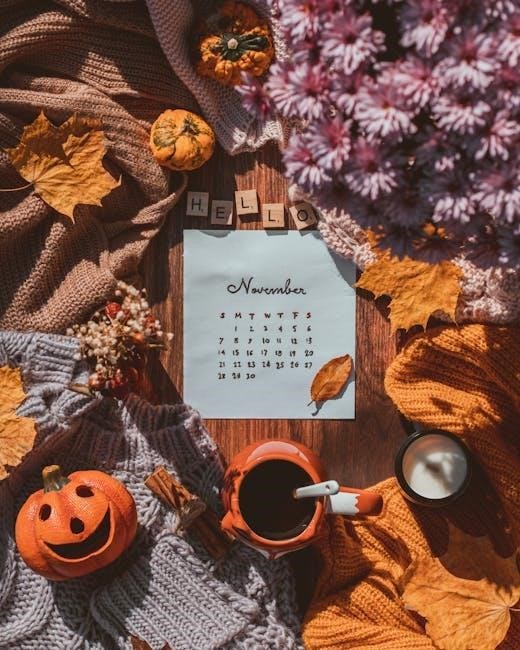Understanding dates in English is essential for clear communication and organization. Dates are used in various formats‚ including numerical and written styles‚ and vary by region.
1.1 Importance of Understanding Dates in English
Understanding dates in English is crucial for effective communication and organization. Accurate date formatting is essential in formal documents‚ emails‚ and academic writing. It helps avoid misunderstandings in international interactions. Knowing how to write and pronounce dates correctly is vital for professionalism and clarity. Additionally‚ it aids in navigating cultural differences‚ as date formats vary between regions. Mastery of English dates enhances overall language proficiency and ensures precision in both written and spoken contexts. This skill is indispensable in everyday and professional life.
1.2 Common Formats for Writing Dates in English
Dates in English are typically written in two main formats: numerical and word-based. The numerical format is MM/DD/YYYY (e.g.‚ 07/31/2025) in American English and DD/MM/YYYY (e.g.‚ 31/07/2025) in British English. The word format includes the day‚ month‚ and year‚ such as “August 31‚ 2025.” Proper punctuation and capitalization are essential; Using consistent formats ensures clarity and avoids confusion‚ especially in formal documents and international communication. Mastering these formats is key to effective written and spoken English.

Basic Date Formats in English
Dates in English are written in numerical or word formats. Numerical formats use MM/DD/YYYY (US) or DD/MM/YYYY (UK). Word formats include the day‚ month‚ and year.
2.1 Writing Dates in Numerical Format
Numerical date formats in English typically follow MM/DD/YYYY in American English and DD/MM/YYYY in British English. For example‚ July 31‚ 2025‚ is written as 07/31/2025 in the US and 31/07/2025 in the UK. This format is widely used for its clarity and efficiency‚ especially in formal documents and digital applications. Consistency is key to avoid confusion‚ particularly when communicating internationally.
2.2 Writing Dates in Word Format
Dates in word format involve spelling out the day‚ month‚ and year in full. For example‚ July 31‚ 2025‚ is written as July 31‚ 2025. In British English‚ the format is 31 July 2025‚ while American English often includes the day before the month. This style is commonly used in formal writing‚ such as letters or official documents‚ to ensure clarity and avoid ambiguity. Proper use of ordinal numbers and month names is essential for accuracy.
2.3 Differences Between British and American Date Formats
The primary difference between British and American date formats lies in the order of day and month. In British English‚ dates are written as day/month/year‚ e.g.‚ 31/07/2025. Conversely‚ American English uses month/day/year‚ such as 07/31/2025. This distinction can lead to confusion‚ especially in international communication. Awareness of these formats is crucial for clarity in written and spoken English‚ ensuring that dates are interpreted correctly across different regions. Understanding these variations aids in avoiding misunderstandings in both personal and professional contexts.

How to Say Dates in English
Saying dates in English involves using cardinal numbers with ordinal indicators (e.g.‚ twenty-first). Dates are typically spoken as “the [ordinal] of [month]‚ [year]” or “on [date].”
3.1 Pronouncing Numbers for Dates
Pronouncing numbers for dates requires clarity and accuracy. Cardinal numbers like “twenty‚” “thirty‚” or “forty” are used for days. Ordinal numbers like “first‚” “second‚” or “twenty-first” are also key. Months are pronounced as their names‚ such as “January” or “July.” Years are typically read as numbers‚ e.g.‚ “2023” is “twenty twenty-three.” Proper intonation and stress are essential for clear communication. Practice is crucial to master this skill effectively in spoken English.
3.2 Using Ordinal Numbers in Dates
Ordinal numbers are essential for expressing dates in English. Days are represented using words like “first‚” “second‚” or “twenty-first.” For example‚ “the 1st of January” or “January 1st.” Ordinal numbers are formed by adding “-st‚” “-nd‚” or “-rd” to cardinal numbers‚ with exceptions for 11th‚ 12th‚ and 13th‚ which use “-th.” Correct usage is crucial for clarity‚ ensuring dates are communicated accurately in both spoken and written English. Consistency in using ordinal numbers helps avoid confusion in date-related communication.
3.3 Common Phrases for Expressing Dates
Common phrases for expressing dates in English include “on [date]‚” “in [month/year]‚” and “by [date].” Phrases like “from [start date] to [end date]” or “during [month/year]” are also frequently used. Prepositions such as “by‚” “from‚” and “until” are essential for indicating deadlines or periods. For example‚ “The deadline is by Friday” or “The event runs from Monday until Sunday.” Additionally‚ phrases like “as of [date]” and “effective [date]” are used in formal contexts. Mastering these phrases ensures clear and accurate communication of dates in various situations.

Ordinal Numbers in Dates
Ordinal numbers like “1st‚ 2nd‚ 3rd” are used to denote the day in dates‚ ensuring clarity in both written and spoken English‚ and consistency across formats.
4.1 Understanding Ordinal Numbers
Ordinal numbers indicate position or order‚ essential for expressing dates accurately. In English‚ they are formed by adding “-st‚” “-nd‚” “-rd‚” or “-th” to numbers‚ with exceptions for 11‚ 12‚ and 13‚ which use “-th.” Correct usage ensures clarity‚ whether written or spoken‚ and is consistent across all date formats in both British and American English‚ avoiding confusion in communication and documentation.
4.2 Formation of Ordinal Numbers in English
Ordinal numbers in English are formed by adding specific suffixes to cardinal numbers: “-st” for 1st‚ “-nd” for 2nd‚ “-rd” for 3rd‚ and “-th” for all others. Exceptions include 11th‚ 12th‚ and 13th‚ which always use “-th.” For example‚ 1st (first)‚ 2nd (second)‚ 3rd (third)‚ and 4th (fourth). This pattern ensures consistency in both British and American English‚ aiding clear communication when expressing dates or sequences. Proper formation is essential for accuracy and professionalism in written and spoken contexts.
4.3 Special Cases for Ordinal Numbers
Ordinal numbers have exceptions‚ such as 11th‚ 12th‚ and 13th‚ which always end with “-th.” Decades like “the 90s” become “the 90th” in ordinal form. Hyphens are used in compounds‚ e.g.‚ “21st-century.” Numbers ending in 1‚ 2‚ or 3 (except 11‚ 12‚ 13) add “-st‚” “-nd‚” or “-rd.” These rules ensure clarity in dates and sequences‚ avoiding confusion. Proper usage is crucial for accurate communication in both written and spoken English‚ especially in formal contexts like documents and official correspondence.

Common Date-Related Phrases
Phrases like “today‚” “tomorrow‚” and “yesterday” are used for days. Months are often expressed as “in January” or “on the 15th.” Years are stated as “in 2023.”
5.1 Phrases for Days of the Week
Common phrases for days include “today‚” “tomorrow‚” “the day before yesterday‚” “yesterday‚” and “the day after tomorrow.” People also use phrases like “in the morning‚” “in the afternoon‚” or “in the evening” to specify parts of the day. Additionally‚ phrases like “on weekdays‚” “on weekends‚” “every Monday‚” or “at the beginning/end of the week” are frequently used to express routines or schedules. These phrases help structure communication about time and daily activities effectively.
5.2 Phrases for Months of the Year
Common phrases for months include “in January‚” “by March‚” or “at the end of December.” People also use phrases like “from April to June” or “during the summer months” to express duration. Additionally‚ phrases such as “every July” or “on the first of October” are used to specify events or deadlines. These phrases help clarify timing and scheduling‚ making communication about longer periods more precise and effective in both written and spoken English.

5.3 Phrases for Years and Decades
Common phrases for years include “in the year 2025‚” “as of 2023‚” or “by 2025.” For decades‚ phrases like “in the 2010s” or “during the 2020s” are used. Specific expressions such as “in early 2019” or “by the end of 2024” clarify timing. Decade-related phrases like “throughout the 2010s” or “in the mid-2020s” are also common. These phrases help express longer time frames effectively in both spoken and written English‚ making communication about years and decades clear and precise.

Cultural Differences in Date Representation
Date formats vary across cultures‚ with British English often using DD/MM/YYYY and American English using MM/DD/YYYY. These differences can lead to confusion‚ emphasizing the need for clarity in global communication.
6.1 Differences in Date Formats Across English-Speaking Countries
In English-speaking countries‚ date formats vary significantly. The United States typically uses the MM/DD/YYYY format‚ while the United Kingdom and other Commonwealth nations prefer DD/MM/YYYY. For example‚ July 4‚ 2023‚ is written as 07/04/2023 in American English and 04/07/2023 in British English. This difference can lead to confusion in international communication. Additionally‚ some countries like Canada and Australia may use a combination of both formats depending on the context. Understanding these differences is crucial for clear and effective communication across cultures.
6.2 Cultural Significance of Dates in English-Speaking Countries
Dates hold cultural and practical significance in English-speaking countries‚ influencing communication and traditions. In the U.S.‚ July 4th is celebrated as Independence Day‚ while in the U.K.‚ holidays like Boxing Day (December 26) are unique. Dates are also crucial in formal documents‚ such as contracts and legal papers‚ where clarity is essential. Additionally‚ academic and social events‚ like university terms or festivals‚ are often tied to specific dates. Understanding these cultural nuances ensures effective communication across diverse English-speaking communities.
6.3 Common Mistakes in Date Representation
Common errors in date representation often arise from format confusion‚ such as mixing day and month in British and American styles. Forgetting to use ordinal numbers (e.g.‚ “5 August” instead of “5th August”) is another frequent mistake. Additionally‚ incorrect placement of the year or omitting it entirely can cause ambiguity. Misuse of punctuation‚ like missing commas or slashes‚ can also lead to confusion. It’s important to maintain consistency in date formats within documents to avoid misinterpretation and ensure clarity in communication.

Practical Applications of Dates in English
Dates are essential in formal documents‚ legal papers‚ and business communications‚ ensuring clarity and accuracy in scheduling‚ record-keeping‚ and international correspondence;
7.1 Filling Out Forms and Documents
Filling out forms and documents requires accurate date formatting. In official contexts‚ dates are crucial for record-keeping and legal processes. Numerical formats like MM/DD/YYYY are common in forms‚ while written dates are often used in formal letters. For example‚ “July 31‚ 2025” or “31 July 2025” depending on regional preferences. Ensuring consistency and correctness is vital to avoid misunderstandings. Always verify the required format to comply with specific guidelines‚ especially in legal‚ academic‚ or professional settings. attention to detail prevents errors and ensures clarity in communication.
7.2 Writing Formal Letters and Emails
In formal letters and emails‚ dates are typically placed at the top right or left‚ depending on the style. The preferred format is Day-Month-Year (e.g.‚ 31 July 2025) or Month-Day-Year (e.g.‚ July 31‚ 2025). British English often uses the former‚ while American English favors the latter. Consistency is key to maintaining professionalism. Always include the date clearly to ensure recipients understand the context and timeline. Proper formatting avoids confusion and enhances the credibility of your communication. Attention to detail in dates reflects overall professionalism and respect for the reader.
7.3 Using Dates in Academic Writing
In academic writing‚ dates are crucial for citing sources and establishing context. The preferred format is Day-Month-Year (e.g.‚ 31 July 2025) or Month-Day-Year (e;g.‚ July 31‚ 2025)‚ depending on the style guide. Consistency is key to maintaining clarity. When citing historical events or research‚ include the date to provide context. For publications‚ use the format specified by the chosen citation style (e.g.‚ APA‚ MLA). Properly formatted dates enhance the credibility and accuracy of academic work‚ ensuring readers understand the timeline and relevance of the information presented.

Resources for Learning Dates in English
Recommended PDF guides offer structured learning‚ while online tools provide interactive practice. Mobile apps enable convenient‚ on-the-go mastering of English date formats and expressions.
8.1 Recommended PDF Guides for Learning English Dates
PDF guides are an excellent resource for mastering English dates. They often include clear explanations‚ practical examples‚ and exercises to practice date formats. Many guides cover both numerical and written styles‚ ensuring a comprehensive understanding. They also address differences between British and American date formats‚ which is crucial for avoiding confusion. Additionally‚ PDF guides frequently highlight common phrases and ordinal numbers used in dates. Their portability and offline accessibility make them a convenient option for learners. By using these guides‚ you can systematically improve your ability to write and express dates in English with confidence.
8.2 Online Tools for Practicing Date Formats
Online tools offer interactive ways to practice English date formats. Websites like Quizlet and Khan Academy provide interactive exercises and quizzes to test your understanding. Tools such as Grammarly and ProWritingAid include features to check date formats for accuracy. Additionally‚ platforms like Duolingo and Babbel offer date-related exercises tailored to language learners. These tools often include real-time feedback‚ helping you identify and correct mistakes. They also cover both British and American date styles‚ ensuring versatility in learning. Using these resources regularly can significantly improve your proficiency in writing and understanding English dates.
8.3 Mobile Apps for Learning English Dates
Mobile apps provide convenient ways to practice English dates on the go. Apps like Duolingo and Memrise offer interactive exercises focused on date formats and vocabulary. Busuu and Babbel include date-related lessons with quizzes and pronunciation tips. The British Council’s IELTS Prep App also covers date formats for academic writing. These apps often feature offline access‚ making them ideal for anytime learning. By using these tools‚ learners can master both British and American date styles effectively‚ ensuring clarity in their communication.

Avoiding Common Errors
Common mistakes include mixing date formats and misusing ordinal numbers. Always double-check the format required and practice pronunciation to ensure accuracy and clear communication in English dates.
9.1 Common Mistakes in Writing Dates
When writing dates in English‚ common errors include confusion between British and American formats. Many people incorrectly use the day before the month or vice versa. Additionally‚ omitting the ordinal indicator (st‚ nd‚ rd‚ th) is a frequent mistake. Others may mix numerical and written formats inconsistently; It’s also easy to misplace commas or slashes‚ leading to unclear dates. To avoid these errors‚ always confirm the required format and double-check the use of ordinals and punctuation. Consistency is key to ensuring clarity in written dates.
9.2 Common Mistakes in Saying Dates
When speaking dates in English‚ common errors include mispronouncing ordinal numbers‚ such as saying “the five” instead of “the fifth.” Many learners omit the “th” sound in numbers like thirty‚ pronouncing it as “thiry.” Additionally‚ stress placement in month names‚ like “DecemBER” instead of “Decemér‚” can cause confusion. Another mistake is omitting the preposition “of” when stating dates‚ such as “July 5th” instead of “the 5th of July.” Regular practice and exposure to native pronunciation can help avoid these errors and improve clarity in spoken dates;
9.3 Tips for Avoiding Errors
To avoid errors when writing and saying dates in English‚ practice regularly and use reliable resources. Pay attention to ordinal number endings (-st‚ -nd‚ -rd‚ -th) and ensure correct pronunciation. Double-check date formats‚ especially the difference between British and American styles. Use tools like grammar checkers and language learning apps to reinforce correct usage. Additionally‚ immerse yourself in native English materials‚ such as news articles or videos‚ to familiarize yourself with common phrases and pronunciation. Consistency and exposure are key to mastering dates accurately.
Mastery of English dates enhances communication and organization. Regular practice and exposure to native materials ensure accuracy. Understanding formats and pronunciation is key to clear expression in personal and professional contexts.
10.1 Summary of Key Points
10.2 Importance of Continuous Practice
Continuous practice is vital for mastering English dates‚ as it reinforces learning and builds confidence. Regular exercises help reduce errors and improve fluency in both written and spoken formats. Practicing numerical and word-based dates ensures clarity in communication‚ while exposure to regional variations enhances adaptability. Consistent practice also aids in understanding cultural contexts and common phrases‚ making date usage more intuitive. Over time‚ this dedication leads to mastery and the ability to use English dates accurately and effectively in various situations.
10.3 Final Tips for Mastering English Dates
To master English dates‚ practice consistently and review materials regularly. Utilize online tools and PDF guides for structured learning. Focus on understanding both numerical and word formats‚ as well as cultural differences. Pay attention to ordinal numbers and regional variations in date formats. Set goals to use dates accurately in writing and speech. Stay organized by creating flashcards or calendars for reinforcement. By combining practice with dedication‚ you can confidently use English dates in all contexts‚ ensuring clear and effective communication.
